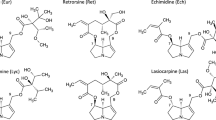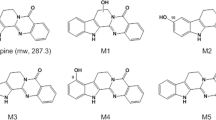Summary
The biotransformation of several analogs of the anti-calcium agent bepridil was studied comparatively in liver cells isolated from one rat. Three types of metabolites were identified by mass spectrometry, resulting from three phase I reactions: hydroxylation, N-debenzylation and pyrrolidine ring opening. The amount of each bepridil analog untransformed after 18 h of incubation depended on its liver toxicity rather than on its concentration in the culture medium. The proportion of phase I metabolites identified remained constant regardless of toxicity. The difference Δc (in %) between the initial concentration of the analog tested and the sum of the concentrations of untransformed material and of identified metabolites decreased with the increasing hepatocyte toxicity. The analogs tested were responsible for the liver toxicity. The presence of substituents in different positions on the N-phenyl moiety increased liver toxicity;ortho-substituted analogs were more toxic thanpara- ormeta-substituted ones.
Similar content being viewed by others
References
Billings R., McMahon R.E., Ashmore J., Wagle S.R. (1977): The metabolism of drugs in isolated rat hepatocytes. A comparison with in vitro drug metabolism and drug metabolism in subcellular liver fractions. Drug Metab. Dispos., 5, 518–526.
Stammati A.P., Silano V., Zucco F. (1981): Toxicology investigation with cell culture systems. Toxicology, 20, 91–153.
Lavrijsen K., Van Houdt J., Van Dyck D., Hendrickx J. et al. (1992): Comparative metabolism of flunarizine in rats, dogs and man: an in vitro study with subcellular liver fractions and isolated hepatocytes. Xenobiotica, 22, 815–836.
Bridges J.W., Benford D.J., Hubbard S.A. (1983): Mechanisms of toxic cell injury. Ann. NY Acad. Sci., 407, 42–63.
Guillouzo A., Begue J.M., Campion J.P., Gascoin M.N., Guguen-Guillouzo C. (1985): Human hepatocyte cultures: a model of pharmaco-toxicological studies. Xenobiotica, 15, 635–641.
Sherratt A.J., Damani L.A. (1989): Activities of cytosolic and microsomal drug oxidases of rat hepatocytes in primary culture. Drug Metab. Dispos., 17, 20–25.
Guzelian P.S., Montgomery A., Bissel M., Meyer U.A. (1977): Drug metabolism in adult rat hepatocytes in primary monolayer culture. Gastroenterology, 72, 1232–1239.
Dougherty K., Spilman S.D., Green C.E., Steward A.R., Byard J.L. (1980): Primary culture of adult mouse and rat hepatocytes for studying the metabolism of foreign chemicals. Biochem. Pharmacol., 29, 2117–2124.
Rogiers V., Vandenberghe A., Callaerts A., Sonck W., Vercruysse A. (1990): Effects of dimethylsulfoxide on phase I and II biotransformation in cultured rat hepatocytes. Toxicity In Vitro, 4, 439–442.
Moldeus P., Hogberg J., Orrenius S. (1978): Microsomal electron transport and cyt P-450. (4) Isolation and use of liver cells. Methods Enzymol., 52, 60–71.
Shrivastava R., John G.W., Rispat G., Chevalier A., Massinhham R. (1991): Can the in vivo maximum tolerated dose be predicted using in vitro techniques? A working hypothesis, ALTA, 19, 393–402.
Wu W.N., Hills J.F., Chang S.Y., Ng K.T. (1987): Metabolism of bepridil in laboratory animals and humans. Drug Metab. Dispos., 16, 69–77.
Gillette J.R. (1979): Effects of induction of cytochrome P-450 enzymes on the concentration of foreign compounds and their metabolites and on the toxicological effects of these compounds. Drug Metab. Rev. 10, 59–87.
Maslansky C.J., Williams G.M. (1982): Primary cultures and the levels of cytochrome P-450 in hepatocytes from mouse, rat, hamster and rabbit liver. In Vitro, 18, 683–693.
Author information
Authors and Affiliations
Rights and permissions
About this article
Cite this article
Damatte, E., Galmier, M.J., Lartigue-Mattei, C. et al. Comparative study of the biotransformation of bepridil analogs in isolated liver cells from one rat. Relationships between structure and in vitro liver toxicity. European Journal of Drug Metabolism and Pharmacokinetics 21, 315–325 (1996). https://doi.org/10.1007/BF03189733
Received:
Issue Date:
DOI: https://doi.org/10.1007/BF03189733




